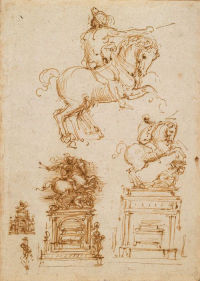Remaking Nature Click on the thumbnails to explore the trail
Read more about this trail (expand)
Leonardo’s ultimate aim was to imitate nature by remaking nature, as opposed to slavishly copying natural forms. This would require a profound understanding of the relationship between the effects of natural appearances and the underlying causes that gave rise to their form. Equipped with this knowledge, Leonardo believed he could create forms equitable to those found in nature, many of which might be of great service to man.

- Enlarge
- The Royal Collection © 2005, Her Majesty Queen Elizabeth II
Studies for the Trivulzio Monument c1508-11
Little remains today of Leonardo’s work as a sculptor. However, his surviving preparatory drawings for sculptural commissions illustrate an acute understanding of three-dimensional form and considerable skill in conveying it in two-dimensions.
In this series of studies related to a monument for the Condottiere Giangiacomo Trivulzio, Leonardo returns to an early idea seen in his Study for the Sforza Equestrian Monument. The rearing horse and rider are shown in profile view in all four studies, probably because the primary objective was the design of the classical pedestal, which is the focus of the lower studies. The three-dimensional forms of the horse and rider have been conveyed with great economy. Curved, parallel hatched lines have been applied to round out the forms in strategic areas, mainly the stomach, rump and neck of the horse, and the twisting back of the rider in the upper drawing.
In the more highly worked study on the lower left, the sense of three-dimensionality is further increased. The turn of the horse’s head not only controls the sense of forward thrust of horse and rider but increases the sense of fluid movement in space.
In Leonardo's words
In that [monument] at Pavia the movement is more to be admired than anything else. The imitation of antique work is more praiseworthy than those of the moderns…The trot almost has the quality of a free horse. Where natural vivacity is lacking it must be supplied by art.
This series of studies is thought to be related to a funerary monument for the Condottiere Giangiacomo Trivulzio, a former enemy of the Sforza who became governor of Milan in 1511.
Leonardo’s design was for a grandiose equestrian statue, which was to feature a bronze horse and rider on top of an elaborately carved marble arch. The design of the base, which appears to have comprised of a sarcophagus within a grandiose structure that is highly reminiscent of a triumphal arch, has been the main pre-occupation of Leonardo’s in the three studies on the lower half of this sheet.
The assured handling of the pen and ink and the wonderfully vivacious quality of the studies of horse and rider indicates Leonardo’s confidence in the technique at this relatively late stage in his career, and the extent of his knowledge of equestrian form, which was the result of many years of intense study.
There is little evidence that the project got beyond the planning stage and Trivulzio actually lived on until 1518, when he died at Chartres just a few months before Leonardo.
- Medium Pen and ink on light tan coloured paper
- Size 27.8 x 19.8 cm
- Location The Royal Collection










